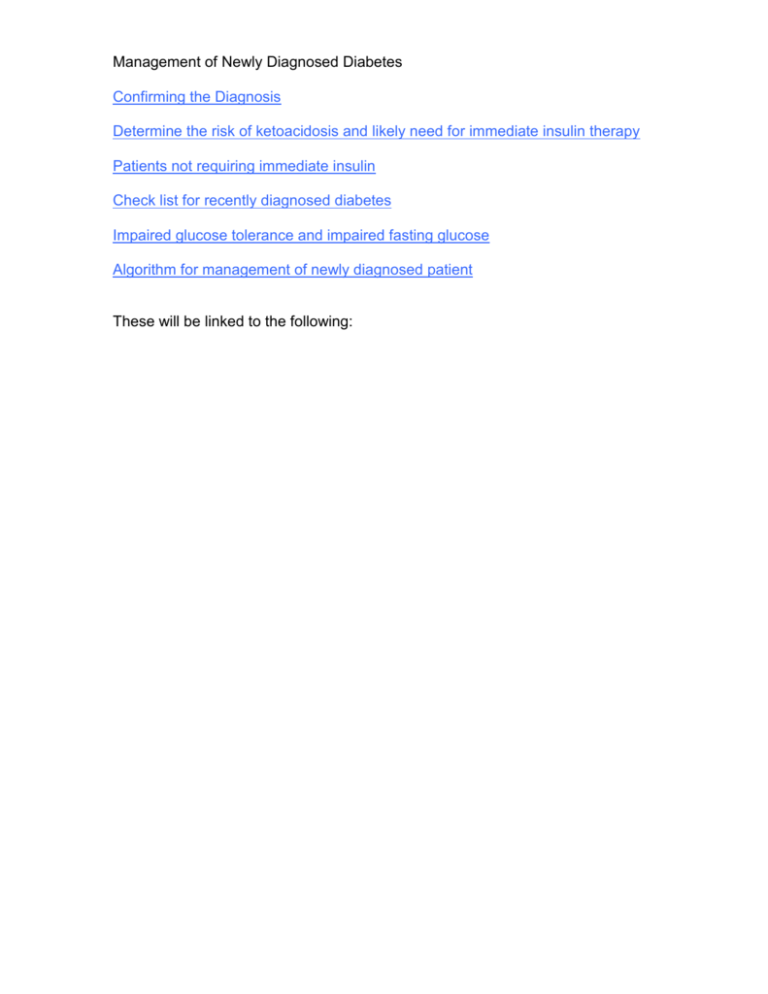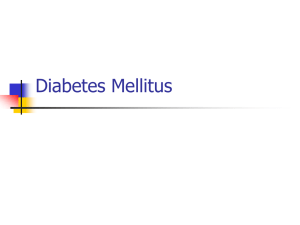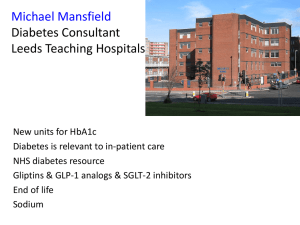Management of Newly Diagnosed Diabetes
advertisement

Management of Newly Diagnosed Diabetes Confirming the Diagnosis Determine the risk of ketoacidosis and likely need for immediate insulin therapy Patients not requiring immediate insulin Check list for recently diagnosed diabetes Impaired glucose tolerance and impaired fasting glucose Algorithm for management of newly diagnosed patient These will be linked to the following: Confirming the diagnosis In the presence of dehydration or heavy ketonuria, a presumptive diagnosis of diabetes may be made on the basis of urinalysis and/or blood strip testing and urgent referral is likely to be appropriate. Otherwise it is essential that a diagnosis of diabetes is confirmed before the patient is advised that he/she has diabetes and before treatment with diet or any other agent is commenced. Symptoms of thirst and polyuria or the finding of glycosuria should prompt blood glucose measurement using a laboratory method. The diagnosis of diabetes should not be made on the basis of portable blood glucose meter results alone. The diagnosis can be made on the basis of symptoms (thirst and polyuria) and one diagnostic blood glucose measurement. The values of blood glucose indicative of diabetes are as follows; Random venous plasma glucose Fasting plasma glucose Venous plasma glucose at 2 hours after a 75g oral glucose load (the oral glucose tolerance test; See Appendix 1 ). In the absence of symptoms the diagnosis is based on two diagnostic blood glucose measurements on two separate days. On rare occasions therefore a second oral glucose tolerance test may need to be performed before a diagnosis of diabetes can be confirmed. In the UK the 2000 WHO criteria were adopted from June 2000. Interpretation of Plasma Glucose Levels (mmol/l) Fastin g Venou s Capillar y Rando m Venou s Capillar y Diabetic range 5.5 < 11.1 6.1< 7.0 6.1 < 7.0 6.5 < 12.2 Check fasting glucose Impaired Fasting Glucose (IFG) - 75g OGTT required 75g OGTT required Diabetes unlikely Interpretation of 75g Oral Glucose Tolerance Test (WHO 2000) Glucose (mmol/l) Fasting 2 Hour Diabetes Mellitus Venous Plasma Capillary Plasma Impaired glucose tolerance Venous Plasma <7.0 and 11.1 Capillary Plasma <7.0 and 12.2 Determine the risk of ketoacidosis and likely need for immediate insulin therapy The most important decision once the diagnosis has been made is to decide whether the patient is at risk of ketoacidosis and likely to require immediate insulin therapy. Indications for immediate insulin therapy Persistent non-fasting ketonuria Marked weight loss in the normal or underweight patient Vomiting and dehydration (will require immediate hospital admission for intravenous therapy). The initial blood glucose level or presence of primary symptoms of thirst and polyuria are not good guides as to the need for insulin. Hospital admission may be avoided in patients who clearly require insulin, but are not dehydrated or in ketoacidosis, depending on the logistics of arranging to start insulin at home on an urgent basis. Such patients should be discussed by telephone with a member of the diabetes specialist team with a view to starting insulin within 24 hours. These patients should receive immediate care from the hospital diabetes team and may be admitted to hospital depending on the practicalities of starting insulin at home. Patients with signs of ketoacidosis or dehydration should be admitted to hospital under the emergency admissions system. Children under the age of fourteen should be discussed urgently on the telephone with a paediatrician, and will normally be admitted to hospital. Patients not requiring immediate insulin The majority of newly diagnosed patients have Type 2 diabetes, and the management approach can be more relaxed in timescale. The initial blood glucose level or presence of primary symptoms of thirst and polyuria is not a good guide as to the long term need for hypoglycaemic drug therapy. Patients do not normally require oral hypoglycaemic agents until they have completed at least two or three months on diet alone. Group education facilities are available at a variety of locations throughout the region for the initial education of Type 2 patients. All such patients should initially receive dietary advice aiming to optimise body weight (see diet section). General advice and the provision of the Diabetes UK diet leaflet is acceptable for initial management, but all patients should be referred to a dietitian at an early stage for more detailed and personalised advice. Obese patients (BMI > 30kg/m2) inadequately controlled after a trial of diet but showing evidence of weight loss may be left on diet alone as glycaemic control is likely to continue to improve. Overweight and obese patients (BMI >25) not achieving weight loss may be most appropriately treated with metformin (section 12.4.1) in a low starting dose to minimise gastrointestinal side effects. Patients not overweight (BMI 25kg/m2) but inadequately controlled may be commenced on a sulphonylurea (section 12.4.2). Employment and social issues may also influence the choice of treatment. Check list for recently diagnosed diabetes Once the immediate issue of glycaemic control has been addressed it is important to consider further educational topics and to ensure an adequate physical examination for detection of established complications, which are often present at diagnosis in Type 2 patients. The following checklist is suggested for completion over the first few clinical contacts. Decide on initial blood glucose management and need for immediate insulin or otherwise Provide initial dietary advice and arrange for referral to a dietitian Record weight (kg) and height (m) and calculate body mass index (BMI kg/m 2 ight in metres squared) Record blood pressure Record urinalysis for protein and ketones and glucose Examine feet for signs of neuropathy, peripheral vascular disease or active lesions Provide foot care information Decide on need for referral to a chiropodist Perform or arrange for adequate retinal examination. Record visual acuity (pinhole corrected if worse than 6/9) Arrange biochemical assessment; serum creatinine, LFTs, lipid profile, thyroid function, HbA1C Early morning urine for albumin/creatinine ratio (microalbumin screen) Record smoking status and advise as appropriate Assess cardiovascular risk status (smoking, BP, family history, lipids, proteinuria/microalbuminuria, established macrovascular disease). Consider ECG to assess evidence of previous MI or left ventricular hypertrophy. Decide on appropriate patient self monitoring Discuss hypoglycaemia and its management in all insulin and sulphonylurea treated patients Determine individualised blood glucose treatment targets Provide support literature Cover selected topics from the education checklist with the patient and relevant individuals Discuss driving/DVLA/insurance Consider referral to a diabetes specialist nurse or hospital diabetic clinic Consider causes of secondary diabetes, see Appendix 3 - Secondary Diabetes Ensure patient is registered with practice and regional diabetes register Impaired glucose tolerance & impaired fasting glucose These patients, like those with established diabetes, have an increased risk of macrovascular disease and require assessment and aggressive management of cardiovascular risk factors, dietary and lifestyle advice – See Diet and Smoking and Diabetes. Patients with impaired fasting glucose (IFG) ( 6.1mmol/l, < 7.0mmol/l) should have a 75g OGTT as some will fulfil the criteria for diabetes mellitus on the two hour value. Patients with IGT & IFG should be entered into the practice diabetes register if available. Five per cent per year may go on to develop Type 2 diabetes and will then need appropriate diabetes care. A fasting or random blood glucose level should therefore be measured on an annual basis, or earlier in the event of symptoms in people with IGT or IFG and the results interpreted according to confirming the diagnosis Algorithm see separate file for this diagram







